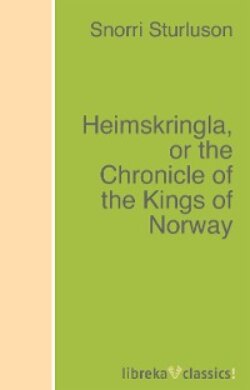Читать книгу Heimskringla, or the Chronicle of the Kings of Norway - Snorri Sturluson - Страница 134
16. GUNHILD'S SONS LEAVE THE COUNTRY.
ОглавлениеEarl Hakon proceeded northwards along the coast with his force; and when Gunhild and her sons got the tidings they proceeded to gather troops, but were ill off for men. Then they took the same resolution as before, to sail out to sea with such men as would follow them away to the westward (A.D. 969). They came first to the Orkney Islands, and remained there a while. There were in Orkney then the Earls Hlodver. Arnfid, Ljot, and Skule, the sons of Thorfin Hausakljufer.
Earl Hakon now brought all the country under him, and remained all winter (A.D. 970) in Throndhjem. Einar Skalaglam speaks of his conquests in "Vellekla":—
As Hakon the earl proceeded this summer along the coast subjecting all the people to him, he ordered that over all his dominions the temples and sacrifices should be restored, and continued as of old. So it is said in the "Vellekla":—
The first winter that Hakon ruled over Norway the herrings set in everywhere through the fjords to the land, and the seasons ripened to a good crop all that had been sown. The people, therefore, laid in seed for the next year, and got their lands sowed, and had hope of good times.
17. HAKON'S BATTLE WITH RAGNFRED.
King Ragnfred and King Gudrod, both sons of Gunhild and Eirik, were now the only sons of Gunhild remaining in life. So says Glum Geirason in Grafeld's lay:—
Ragnfred began his course in the spring after he had been a year in the Orkney Islands. He sailed from thence to Norway, and had with him fine troops, and large ships. When he came to Norway he learnt that Earl Hakon was in Throndhjem; therefore he steered northwards around Stad, and plundered in South More. Some people submitted to him; for it often happens, when parties of armed men scour over a country, that those who are nearest the danger seek help where they think it may be expected. As soon as Earl Hakon heard the news of disturbance in More, he fitted out ships, sent the war-token through the land, made ready in all haste, and proceeded out of the fjord. He had no difficulty in assembling men. Ragnfred and Earl Hakon met at the north corner of More; and Hakon, who had most men, but fewer ships, began the battle. The combat was severe, but heaviest on Hakon's side; and as the custom then was, they fought bow to bow, and there was a current in the sound which drove all the ships in upon the land. The earl ordered to row with the oars to the land where landing seemed easiest. When the ships were all grounded, the earl with all his men left them, and drew them up so far that the enemy might not launch them down again, and then drew up his men on a grass-field, and challenged Ragnfred to land. Ragnfred and his men laid their vessels in along the land, and they shot at each other a long time; but upon the land Ragnfred would not venture: and so they separated. Ragnfred sailed with his fleet southwards around Stad; for he was much afraid the whole forces of the country would swarm around Hakon. Hakon, on his part, was not inclined to try again a battle, for he thought the difference between their ships in size was too great; so in harvest he went north to Throndhjem, and staid there all winter (A.D. 971). King Ragnfred consequently had all the country south of Stad at his mercy; namely, Fjord district, Hordaland, Sogn, Rogaland; and he had many people about him all winter. When spring approached he ordered out the people and collected a large force. By going about the districts he got many men, ships, and warlike stores sent as he required.
